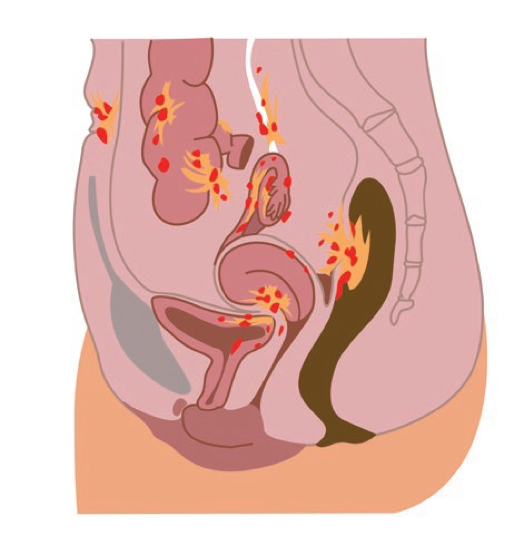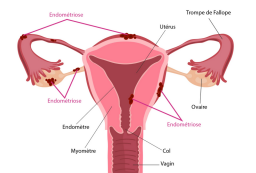Qu’est-ce que l’endométriose ?
L’endométriose est une maladie gynécologique chronique, encore largement sous- estimée et qui touche environ 10% des femmes en âge de procréer. Cette maladie peut débuter dès les premières règles et les symptômes ne cessent (en général) qu’à la ménopause.
Pour bien comprendre l’endométriose, il faut d’abord comprendre le fonctionnement du corps féminin :
Tout au long du cycle menstruel (un cycle menstruel commence le premier jour des règles et se termine le premier jour des règles suivantes), l’endomètre (tissu qui tapisse la paroi interne de l’utérus) s’épaissit afin d’accueillir un éventuel embryon. Si en fin de cycle, il n’y a pas eu de fécondation, alors, l’endomètre se désagrège naturellement par le biais de saignements;
c’est ce qu’on appelle plus communément les règles
Chez les femmes atteintes d’endométriose, des cellules semblables à l’endomètre migrent et s’implantent soit en dehors de leur place habituelle qu’est l’utérus (le système reproducteur, l’appareil urinaire/digestif/pulmonaire,…) et on parle alors d’endométriose, soit s’infiltrent dans le myomètre (qui est le muscle utérin) et on parle alors d’adénomyose, autrement dit, la cousine de l’endométriose.
Ces cellules semblables à celles de l’endomètre deviennent des foyers d’endométriose et se situent le plus souvent dans le bas du ventre : sur le péritoine (qui est une membrane recouvrant les organes de l’abdomen), sur les ovaires, dans l’intestin ou la vessie ou, plus rarement, sur d’autres organes (diaphragme, plèvre, poumons).
Not only does endometriosis disrupt the physical well-beingbut it can also have consequences psychological, social and affect the relationship with the partner..
Endometriosis lesions can be of three types:
- superficial and affect the peritoneum
- adnexal and therefore touch the ovaries and tubes.
- deep (beyond 5mm from the peritoneum) and infiltrate mainly the utero-sacral ligaments (which connect the uterus to the sacrum at the back, more frequent on the left), the rectum and the bladder.
Remember that there is no correlation between the intensity of the pain or the type of endometriosis and that superficial endometriosis can be very painful.


Comme l’endomètre, les foyers d’endométriose réagissent au cycle de la femme et saignent (comme
les règles) car ils sont sous l’influence hormonale du cycle menstruel. C’est pour cette raison que
l’endométriose est caractérisée de a hormone-dependent disease (sa progression dépend des hormones
féminines). Contrairement au liquide menstruel qui à chaque cycle s’écoule par le vagin, le sang issu
des foyers d’endométriose ne peut pas s’écouler ; sa persistance au sein des lésions peut expliquer la douleur.
En mots simples : à chaque fois que la femme à ses règles, les foyers d’endométriose sont réactifs et
cela crée de l’inflammation ce qui peut être très douloureux et c’est cela qui explique que le principal symptôme de
l’endométriose est d’avoir des règles très douloureuses.
